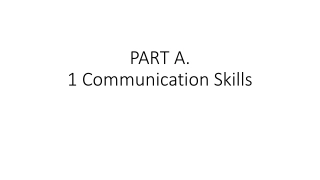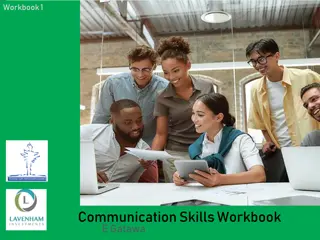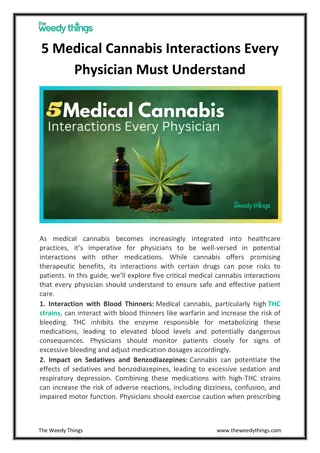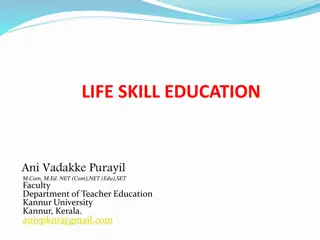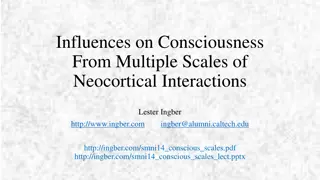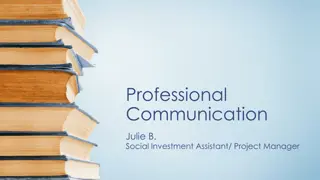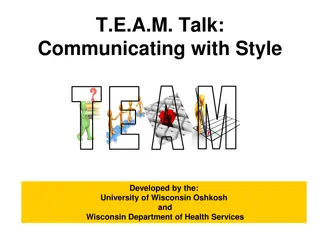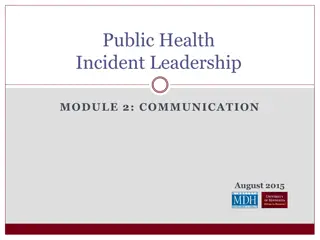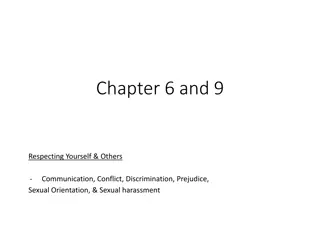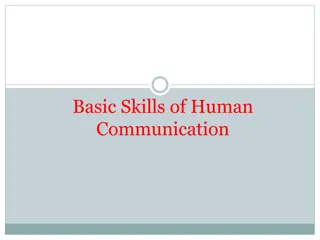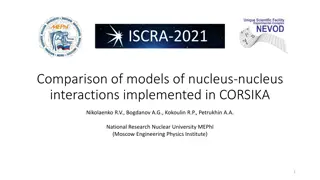Enhancing Communication Skills for Effective Interactions
Effective communication involves exchanging ideas and information to fulfill intentions clearly and concisely. Key characteristics include clear, correct, reliable, complete messages with consideration for the recipient. Developing skills in observance, clarity, listening, emotional intelligence, self-efficacy, self-confidence, respectfulness, non-verbal communication, medium selection, and feedback is crucial for successful communication.
- Communication skills
- Effective communication
- Interpersonal communication
- Non-verbal communication
- Listening skills
Download Presentation

Please find below an Image/Link to download the presentation.
The content on the website is provided AS IS for your information and personal use only. It may not be sold, licensed, or shared on other websites without obtaining consent from the author. Download presentation by click this link. If you encounter any issues during the download, it is possible that the publisher has removed the file from their server.
E N D
Presentation Transcript
Effective Communication 2020 COMMUNICATION SKILLS
What is effective communication? Effective communication is a process of exchanging ideas, thoughts, knowledge and information such that the purpose or intention is fulfilled in the best possible manner. In simple words, it is nothing but the presentation of views by the sender in a way best understood by the receiver.
Content: Of Effective Communication 1. Characteristics 2. Skills 3. Significance 4. Barriers
Characteristics Clear Message: The message which the sender wants to convey must be simple, easy to understand and systematically framed to retain its meaningfulness. Correct Message: The information communicated must not be vague or false in any sense; it must be free from errors and grammatical mistakes. Complete Message: Communication is the base for decision making. If the information is incomplete, it may lead to wrong decisions. Precise Message: The message sent must be short and concise to facilitate straightforward interpretation and take the desired steps. Reliability: The sender must be sure from his end that whatever he is conveying is right by his knowledge. Even the receiver must have trust on the sender and can rely on the message sent. Consideration of the Recipient: The medium of communication and other physical settings must be planned, keeping in mind the attitude, language, knowledge, education level and position of the receiver. Sender s Courtesy: The message so drafted must reflect the sender s courtesy, humbleness and respect towards the receiver.
Skills Observance: A person must possess sharp observing skills to gain more and more knowledge and information. Clarity and Brevity: The message must be drafted in simple words, and it should be clear and precise to create the desired impact over the receiver. Listening and Understanding: The most crucial skill in a person is he must be a good, alert and patient listener. He must be able to understand and interpret the message well. Emotional Intelligence: A person must be emotionally aware and the ability to influence others from within. Self-Efficacy: Also, he/she must have faith in himself and his capabilities to achieve the objectives of communication.
Skills Self-Confidence: Being one of the essential communication skills, confidence enhances the worthiness of the message being delivered. Respectfulness: Delivering a message with courtesy and respecting the values, believes, opinions and ideas of the receiver is the essence of effective communication. Non-Verbal Communication: To connect with the receiver in a better way, the sender must involve the non-verbal means communication too. These include gestures, facial expressions, eye contact, postures, etc. Selection of the Right Medium: Choice of the correct medium for communication is also a skill. It is necessary to select an appropriate medium according to the situation, priority of the message, the receiver s point of view, etc. Providing Feedback: Effective communication is always a two-way process. A person must take as well as give feedback to bring forward the other person s perspective too.
Significance Employee Management: Effective communication ensures self-discipline and efficient management since the employees are heard by the top management, and there is open communication in the organisation. Team Building: People in the organisation work as a team to accomplish common goals, thus effective communication boosts the morale of the whole team. Growth of the Organization: It ensures better decision making, intensifies public relations and enhances problem-solving ability. All this leads to corporate growth and development. Build Strong Relationships: Interactions often simplify things; they positively motivate the employees to perform better and maintain long-term relations with others in the organisation. Ascertain Transparency and Develops Trust: Effective communication is considered to be a base for building trust and assures sharing of complete information. Facilitates Creativity and Innovation: It creates an environment where employees are free to share their ideas by exploring their creative and innovative side.
Barriers Barriers Language: It is a medium of communication. If the sender is making excessive use of technical terms, it will become difficult for the receiver to understand the message clearly. Ambiguity and Overuse of Abstractions: Even if the message is presented in a non-realistic or vague context involving a lot of notions, the receiver won t be able to connect with the idea properly. Disorganised Message: When the words are not organised systematically to form a powerful message, it loses its efficiency and meaning. Information Overload: The effectiveness of communication reduces when a person keeps on speaking for an extended period. Thus, leading to the receiver s exhaustion, who won t be able to keep track of everything that is conveyed.
Barriers Involving Peoples Background Attitudinal Differences: At times, people are resistant to understand or change their mind when they have set their views about a particular topic. Their attitude obstructs meeting the purpose of the communication. Demographic Differences: The difference in age, generation, gender, status, tradition, etc., creates a lack of understanding among people and thus, hinders the process of communication. Lack of Common Experience or Perspective: The experiences of a person develops their perspective of seeing things in a particular way. This perspective varies from person to person. Therefore, it becomes difficult for a receiver to relate with the sender s experience or views as he might have never gone through it himself. Jumping to Conclusions: Some people lack the patience of listening to others and often jump to conclusions between the communication, thus neglecting the motive of the message.
Physical Barriers Physical Distance: When people communicate over long distances, they miss out the non-verbal aspect of communication, since the gestures and expressions of the receiver cannot be interpreted. Noise: The environment or the communication system sometimes involve unwanted noise which interrupts the process of communication making it inefficient. Physiological Barriers: One of the most common barriers to effective communication is the physical disability of the people involved. Some of these are hearing impairment, poor eyesight, stammering, etc.
Paperwork Remember to ask for help if you need it:
Thank you! HAVE A LOVELY AFTERNOON


